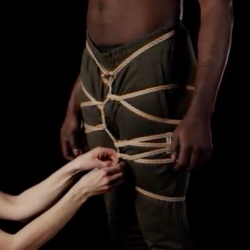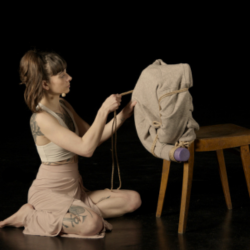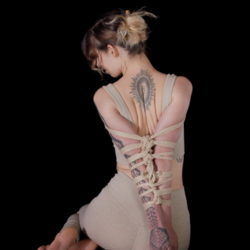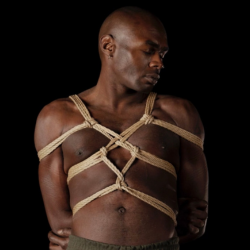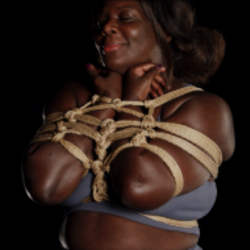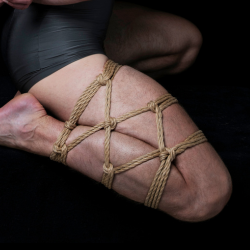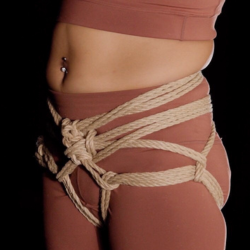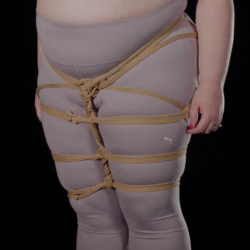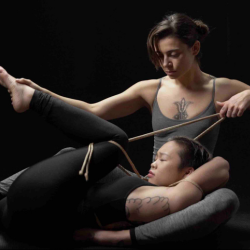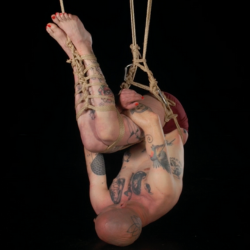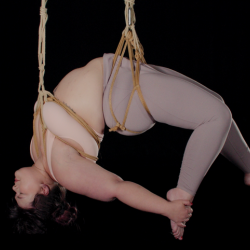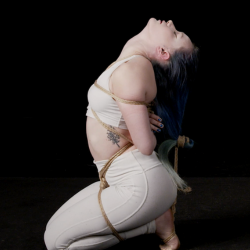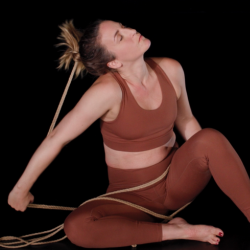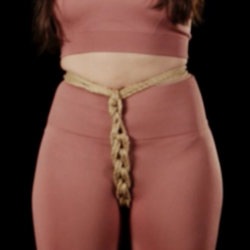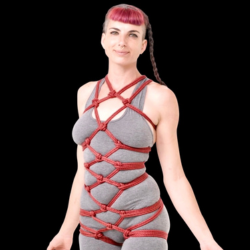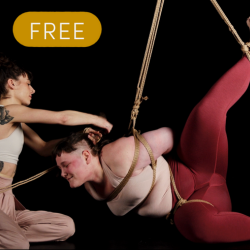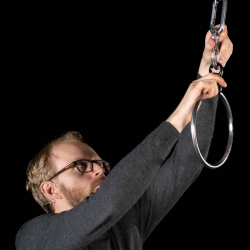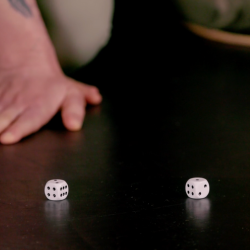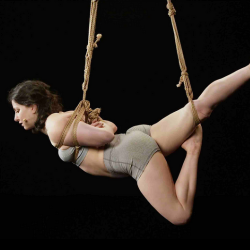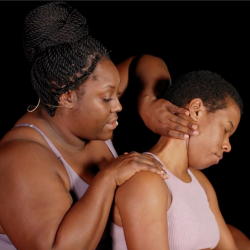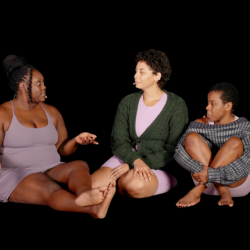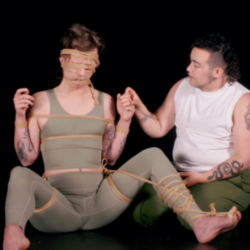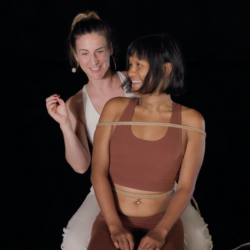SHIBARI STUDY GLOSSARY
I think many budding rope nerds have been there — either at our first workshop, or researching shibari for the first time — when someone uses an unfamiliar Japanese word to describe something and suddenly we feel lost. Maybe we're too shy to ask, or maybe we just internalize the terminology without really understanding what it means.
This Glossary of Shibari Terms started as a passion project but also as a reference table for all the things I have come across that I didn’t understand. Part of the motivation behind publishing it here is to give people access to information and support their journey to learn and evolve in rope, breaking down some of the stigma and elitism of using Japanese terminology, but also to give reverence and appreciation to shibari’s rich and diverse heritage.
It's important to highlight my disclaimer post ‘What’s in a Word?’ and ask that you read through it, as it contains some of my personal approach and opinion on cultural appropriation and the part language plays in this. I have seen many arguments to not use Japanese terminology when describing rope, and although I feel many of these are valid, there is a danger that by removing all references to it, we run into aspects of whitewashing this beautiful art form and sanitizing away some of its important history.
In using this glossary, don’t try to adopt Japanese terminology merely for the sake of it. However, where there are common terms such as gote and futomomo, it's important that we build appreciation for what certain terms mean, removing some of the barriers in communication about the subject of rope bondage and shibari. If you do choose to use Japanese language when describing your rope, consider using your own language first and then giving the Japanese terminology as a way of honoring both your native tongue, and also showing respect to the Japanese lineage, for example, ‘box tie, also known as gote’.
Furthermore, if you notice anything missing, inaccurate or incorrect in this glossary, please do reach out and let me know. We are always prepared to update and refine this resource using the collective knowledge, so it may stand as a trusted piece in the community that holds itself to scrutiny and account. – Mo Bights
A
ABOK – Ashley Book of Knots
ABOK – Ashley Book of Knots
The Ashley Book of Knots. Although not a book specifically related to shibari, this encyclopedia of knots is a seminal work in cataloging all types of knots, with a taxonomy and reference using numerical identifiers. Written by sailor Clifford W. Ashley, the book was first published in 1944 and contains 3,857 numbered entries (although for rope bondage, it’s likely you’ll only use about 10 of these).
Aftercare
In a BDSM context, aftercare is the process of providing a stable and comforting environment to come out of a scene. Aftercare is widely personal and everyone's needs should be assessed independently and negotiated and agreed upon upfront. For some, aftercare might be light, such as a hug, a cup of tea and a chat; for others, this may be more in depth, ranging from hours or even days of adaptive behavior and emotional and/or physical support. An individual's aftercare needs may also vary and, depending on the activity and intensity, won't always be the same from one scene to the next.
Agura shibari (胡座縛り)
Agura shibari (胡座縛り)
Tie with crossed legs. From agura (literally ‘barbaric sitting’), a term used to indicate the way of sitting with crossed legs, usually in the West, and shibari (tie). May also be referred to as zazen shibari, taken from the prayer position of Buddhist monks.
Aibunawa (愛撫繩)
Aibunawa (愛撫繩)
A ‘caressing style’ of rope, developed by Yukimura Haruki sensei. Unlike in semenawa (責め縄 or tormenting rope), where the focus is on torment, tight binding and creating feelings of helplessness, aibunawa ties aren’t too restrictive, intentionally allowing the person being tied to think that they could escape or still retain some sense of freedom or control.
From aibu (to caress) and nawa (ropes).
Amari nawa (余り縄)
Amari nawa (余り縄)
The leftover rope at the end of a tie, which can be incorporated as decorative elements or structural reinforcement.
From amari (leftover) and nawa (rope). May sometimes also be referred to as amatta nawa (余った縄).
Anchor point
Anchor point
An anchor point is any secure point to which rope can be attached. Commonly, these are overhead hard points for suspension, but they can also be lateral, such as wall-mounted rings or hooks.
Aomukezuri (仰向け吊り)
Aomukezuri (仰向け吊り)
A suspension where the model is in a face-up position.
From aomuke (face-up) and tsuri (suspension).
Aranawa (荒縄)
Aranawa (荒縄)
A rope generally made from rice straw and commonly seen in older kinbaku photographs.
Derived from ara (荒 or rough) and nawa (縄 or rope).
Asanawa (麻縄)
Asanawa (麻縄)
Natural fiber rope (as opposed to rope constructed from man-made fibers – for more, check out our Shibari Study Rope Guide). The term asanawa is often why people consider jute to be ‘traditional’ despite the fact that the name asanawa doesn't actually specify what plant the fiber originates from.
Derived from asa (麻, a term for bast fibers such as jute, hemp and linen fiber) and nawa (縄 or rope).
Ashi (足)
Ashi (足)
(Anatomy) Leg. Some shibari positions will refer to ashi and will involve specific leg placements, e.g. Kata Ashi is a form with a single elevated leg. Ashi shibari is the binding of the legs.
Ashikubi (足首)
Ashikubi (足首)
(Anatomy) Ankle. Commonly, this is referenced in the full name of a futomomo tie – ashikubi futomomo shibari (足首 太もも 縛り).
Ashikubi futomomo shibari (足首 太もも 縛り)
Ashikubi futomomo shibari (足首 太もも 縛り)
A futomomo is a bent leg tie, where the ankle is secured to the thigh. The full name derives from ashikubi (ankle), futomomo (thigh) and shibari (tie).
There are many patterns and methods to achieve this, from a simple double-column tie, to complex patterns like the Diamond Futomomo.
B
Bakushi (縛師)
Bakushi (縛師)
Contraction of kinbakushi, a kinbaku teacher.
Derived from kinbaku (緊縛 or tight binding) and shi (師 or teacher).
Band
Band
Usually used in reference to a band of ropes being placed across the body. In shibari, rope is commonly doubled over, so a band may be two or more ropes that lie adjacent to each other.
Battendome (罰点留め)
Battendome (罰点留め)
A sturdy X-shaped friction often used to lock together lines that intersect at right angles or at a T-junction between ropes, commonly seen at the top wrap of a gote (後手).
From batten (the name for the ‘X’ or cross symbol for incorrect) and tome (friction). Also known as an X-Friction.
Bayu (馬油)
Bayu (馬油)
Horse oil – a traditional rope treatment to condition asanawa (麻縄).
Bend
Bend
A bend is a way to join two ropes together. There are many types of bend, including the sheet bend, Ashley's bend and Hunter’s bend.
Bight
Bight
An open-ended loop of rope, often formed in the center of the rope to double the strands. The bight can, however, be formed anywhere along the length of a rope.
See also Nawa Gashira (縄頭).
Bondage
Bondage
This word literally means ‘slavery’ and the modern definition covers a wide range of methods to restrain someone. This may be rope but may also be handcuffs, leather cuffs, mental bondage or any other tools. This is not limited to rope, so commonly ‘rope bondage’ is used to describe bondage that uses exclusively rope.
Boola-boola
Boola-boola
A form of single-column tie, arguably a granny knot single-column tie. However, this is often confused with a square knot (or reef knot) and it can be challenging to know exactly what the ‘true’ boola-boola is. At this point, it’s almost more myth than method. Also referred to as a Yuki Knot, but this differs to the one described in this glossary.
Bō shibari (棒縛り)
Bō shibari (棒縛り)
Tying a model to a pole. When the pole is vertical, this is hashira; bō, instead, refers to poles being used as part of the binding (such as across the arms, spreader bars, etc.). This form has its origins in Kabuki theater plays.
See also Take Shibari (竹縛り).
Bottom
Bottom
In relation to rope, this would be the person being tied. More generally, this is the person to which something is done. It’s not always the case that a bottom is submissive, so the terms should not be used interchangeably.
Bowline
Bowline
A fixed loop, usually formed at the end of a rope, that does not collapse or cinch. Within rope bondage, common variants used are the Somerville Bowline, Burlington bowline, French bowline, Wykd Fast bowline and occasionally Alpine bowline.
Box tie
Box tie
Any form of upper body tie where the arms are tied behind the back accompanied by chest wraps. There are almost as many box tie variations as you could think of, as beyond the initial two ropes used to construct the harness, many third rope variations exist to provide decorative or functional patterns. The ‘box’ refers to the shape the arms and chest make, with four distinct corners.
See also Gote Shibari (後手縛り) and Takate Kote (高手小手縛り).
Bunny
Bunny
Term used to describe a rope bottom. This wording may be contentious in some rope communities and be considered demeaning, so should be a self-elected identifier for those who feel this represents them.
See Rope Bunny.
Buranko (ブランコ)
Buranko (ブランコ)
Using someone suspended in ropes like a swing – the word itself literally means ‘swing’.
Buri buri (ぶりぶり)
Buri buri (ぶりぶり)
A tie with the hands and feet bound together, either in front or behind the body (in suspension, this can switch between both positions), that can be tied with just single-column ties on the wrists and ankles.
This form has a long history dating back to 1600 as a form of torture for disobedient pleasure district sex workers.
See also Tanuki shibari (狸縛り).
C
Carabiner
Carabiner
Climbing equipment sometimes used for suspension. Carabiner can be useful for creating low-friction pulley systems. Be sure to only use rated carabiners with a stated safe working load. Sometimes shortened to ‘biner’.
Chest harness
Chest harness
Any form of harness applied to the chest, which does not incorporate the arms into the tie. Also known as Munenawa (胸縄).
Chikubi (乳首)
Chikubi (乳首)
(Anatomy) Japanese term for the nipple.
Chitsu (膣)
Chitsu (膣)
(Anatomy) Japanese term for the vagina.
Chokushin gote shibari (直進後手縛り)
Chokushin gote shibari (直進後手縛り)
Tie with the arms tied straight behind the back. This is also often referred to by the western name ‘strappado’, although it is worth noting strappado is a specific form of torture where the person is suspended from the arms in such a way that causes significant shoulder damage and/or dislocation.
Derived from chokushin (直進 or straight), gote (後手 or arms behind the back), and shibari (縛り or tie). See also Strappado.
Chōkyō (調教)
Chōkyō (調教)
Discipline. In direct terms, this refers to the breaking of an animal, but it can also be used to refer to erotic discipline.
Cinch
Cinch
Cinches are used to add additional tension to ropes. This is commonly seen in double-column ties and Gote Shibari (後手縛り), where the cinch increases the distance traveled by a loop of rope, thereby giving additional tension.
See also Kannuki (閂).
Clove hitch
Clove hitch
The clove hitch is a type of knot. Along with the bowline and the sheet bend, it’s often considered one of the most important knots. A clove hitch is two successive single hitches around an object. It is most effectively used as a crossing knot.
Assigned the reference ABOK #11 in the Ashley Book of Knots.
Collapse
Collapse
This refers to a knot changing form due to stress/deformation. May also be referred to as 'capsize' or 'capsizing' of the knot.
Cow hitch
Cow hitch
Also known as a lark’s head or hibari musubi, a cow hitch is formed by two half-hitches.
Assigned the reference ABOK #1802 in the Ashley Book of Knots.
Crab tie
Crab tie
A form where the model is tied in a seated position, with arms tied to the adjacent leg.
Sometimes known as a kaikyaku kani shibari (開脚蟹縛り).
Crown knot
Crown knot
A common stopper knot, the crown knot (ABOK #670) is formed by splitting the three strands of rope and interlacing them into each other. This can be used to start a back splice or a crown and wall knot (ABOK #10) or a crown sinnet (ABOK #2912).
Assigned the reference ABOK #670 in the Ashley Book of Knots.
D
Daruma shibari (達磨縛り)
Daruma shibari (達磨縛り)
Tie with the legs tied on the sides and the arms passing through the legs being fixed in place to the hips. Daruma is the name of a traditional Japanese doll, depicting the monk Bodhidharma dressed in red with wide eyes and without arms and legs.
Deshi ( 弟子)
Deshi ( 弟子)
The word consists of two kanji: 弟 ( younger brother) and 子 (child). In kanji and kana, the meaning of deshi is pupil, apprentice or disciple. Disciple implies more than just a student, for which the term is gakusei (学生).
Commonly, a deshi is someone who has shown dedication to a particular school (ryu 流) and is considered to be someone who can continue the teaching of that style, so holding greater responsibility than a simple student: deshi are representatives of their sensei (先生) and the lineage of their style.
Dōjō (道場)
Dōjō (道場)
The word dōjō originates from Buddhism. Initially, dōjō were adjunct to temples and were formal training places for any of the Japanese arts ending in -dō. From dō (way or path) and jō (place), so ‘place where you can follow the way’.
Although many Western rope bondage venues are called dojo, this isn't commonly used in Japan.
Dō nawa (胴縄)
Dō nawa (胴縄)
Waist rope, specifically used in suspension to support the waist. Distinct from koshi nawa, which is around the hips.
Derived from dō (胴 or torso) and nawa (縄 or rope).
Dorei (奴隷)
Dorei (奴隷)
Slave. Its direct translation refers to a person owned by another, forced to work for another or to perform sexual acts, so implies a stronger relationship than simply a 'bottom' or 'model'. However, the word can be used to describe a person in rope.
Double-column tie
Double-column tie
A cuff around more than one limb with the limbs separated by rope. While similar to a single-column tie, a double-column tie creates two separate openings through the use of a cinch/kannuki, which can help to prevent rotation of the cuff around the limbs.
See also Tejō shibari and Kata tekubi shibari (片手首縛り).
Dressing
Dressing
Using the fingers to ensure wraps sit evenly, there are no twists in your ropes and that tension is even. Dressing ropes is particularly important in suspension where ropes will be under load – ensuring correct placement and tension is of utmost importance for safety and sustainability.
Drop
Drop
Drop is an emotional/mental state that can occur after any activity, but often in reference to SM scenes or experiences. This is related to the reduction of endorphins built up during an exciting or intense experience. Drop may happen immediately or may be delayed. Drop can affect both tops and bottoms and aftercare needs should be designed around helping to reduce drop, or to make the experience of drop less severe and more tolerable.
Dungeon
Dungeon
Common name for a BDSM venue that has various equipment for the practice of BDSM-related activities.
Dungeon monitor (DM)
Dungeon monitor (DM)
A person responsible for maintaining safety in a dungeon – often an experienced member of the community who may be trusted to understand safety, consent and risk and mediate/intervene if necessary to provide support.
E
Ebi shibari (海老縛り)
Ebi shibari (海老縛り)
Used as an Edo period torture (ebi-zeme) method, ebi shibari is one of the oldest forms (kata) in shibari. The position is created by sitting the model crossed-legged (agura (胡座縛り) and then compressing the body to the legs. This position causes positional asphyxia and is remarkably intense.
Ebi-zeme (海老責め)
Ebi-zeme (海老責め)
Known as the third technique of Edo period torture. Officially mandated as a torture technique by the rulers of Tokugawa, Japan, in 1742 with the subject being bound in an ebi position.
See also Ebi shibari (海老縛り).
Ebi-zuri (海老吊り)
Ebi-zuri (海老吊り)
Suspension while in the ebi position.
Derived from ebi (海老 or shrimp) and tsuri (吊りor hanging).
Enchou ude mae te shibari (延長腕前手縛り)
Enchou ude mae te shibari (延長腕前手縛り)
‘Reach forward binding’, where arms are tied in front of the body, bound together with a single rope. This may be abbreviated to ‘mae te shibari’ or ‘mae te gassho shibari’.
F
Floorwork
Floorwork
A style of tying that does not utilize suspension lines but rather remains grounded on the floor.
See also Newaza (寝技) and Yuka shibari (床縛り).
Friction
Friction
A friction is a method of locking a section of rope against another rope without actually forming a knot. Common frictions include the X-Friction, Half-Moon Friction and L-Friction.
Frog tie
Frog tie
Tie that binds the hands to the legs in a face-down position, often using double-column ties. This restrains and exposes the bottom and creates an easily accessible position visually similar to a sitting frog.
Fundoshi (褌)
Fundoshi (褌)
The fundoshi is a form of undergarment solely worn by adult males in Japan. Despite the fundoshi dating back to historic times, the garment plays a major role in Japanese culture as festival/celebratory attire. As a female garment, the fundoshi began to be used in historical films during the ‘50s to avoid censorship problems. From that moment, it became a sort of sexy fetish garment for women, making it possible to avoid censorship that, in Japan, forbids genital exposure in photos.
Furoshiki (風呂敷)
Furoshiki (風呂敷)
A square of cloth used for wrapping and carrying objects in Japan. Usually around 70x70cm, there are many ways to tie a furoshiki depending on what you wish to wrap and they are often used for gifts or, in a shibari context, for carrying ropes. The tying of furoshiki can be seen as its own art form.
Fusion bondage
Fusion bondage
Fusion bondage takes elements of both Western and Japanese style rope bondage to create different ties often focused on the aesthetics. This style of rope is usually about artistic expression and is often focused on the final form for show or photography purposes.
Futomomo shibari (太もも縛り)
Futomomo shibari (太もも縛り)
Often diminished to mean ‘fat leg’ from an indication of plumpness in the original meanings, futomomo shibari simply refers to the tying of a bent leg. Futomomo shibari variations can be seen in the Shijuhatte, the Japanese version of the Kama Sutra, which contains 48 sexual positions. Futomomo has many variations and can be used in suspension (tsuri 吊り) or floorwork (newaza 寝技).
G
Ganji garame (ガンジがらめ)
Ganji garame (ガンジがらめ)
To be completely bound, hand and foot, totally immobilized. This can be achieved by various techniques and refers not to the specific technique but to the result.
Gekamusubi (外科結び)
Gekamusubi (外科結び)
Surgeon's knot, similar to a reef knot (hon musubi 本結び) with an extra wrap to add additional internal friction.
Gōmon shibari (拷問縛り)
Gōmon shibari (拷問縛り)
A historic Japanese term used to describe shibari/kinbaku ties that are intended to torment or punish. This can be seen as a part of predicament play.
Goshujinsama (ご主人様)
Goshujinsama (ご主人様)
In Japanese, goshujinsama means the ‘master’ of a servant (or, in anime, mostly of a maid). The word may also refer to the owner of a house or shop, to one's husband, or to a pet's owner. This meaning, master, is actually the original meaning of the word shujin (主人).
Gote shibari (後手縛り)
Gote shibari (後手縛り)
Alternative name of the box tie. Gote derives from the word go (後), which can also be read as ato or ushiro, meaning ‘behind’, and te (手), meaning ‘hand’. Ushirote or gote simply means to tie the hands behind the back.
Granny knot
Granny knot
A granny knot is structurally similar but distinct from a square knot. Commonly used to attach a line to an object, a granny knot is formed by stacking two overhand knots in the same direction (left over left plus left over left, or vice-versa).
Although similar to a reef knot, a granny knot is traditionally seen as weaker. In the context of shibari, this is most commonly used to form a single-column tie, created by wrapping around a limb (column), passing the bight under the cuff, then locking with an overhand knot. The direction of the overhand knot determines whether the result is a granny knot or a square knot.
Assigned the reference ABOK #3 in the Ashley Book of Knots.
Gyaku-ebi shibari (逆海老縛り)
Gyaku-ebi shibari (逆海老縛り)
Gyaku ebi is a form where the arched back is pronounced to create a shape similar to a shrimp (ebi). Derived from gyaku (逆 or reverse) and ebi (海老 or shrimp). This is an intense position commonly formed by tying the legs into a gote (後手), either using single-column ties on the ankles or hips, or using futomomo (太もも).
Gyaku-ebi-zuri (逆海老吊り)
Gyaku-ebi-zuri (逆海老吊り)
Gyaku-ebi-zuri is a suspended version of gyaku ebi. This can be achieved in many ways, but commonly in a face-down suspension.
See also Gyaku ebi shibari (逆海老縛り).
Gyaku gote (逆 後手縛り)
Gyaku gote (逆 後手縛り)
Hands-front version of a takate kote (高手小手), derived from gyaku (reverse/opposite) and gote (hands tied behind back).
See also Jiai shibari (自愛縛り).
Gyaku shakuhachi shibari (逆 尺八縛り)
Gyaku shakuhachi shibari (逆 尺八縛り)
Arms tied behind the back in a position intended to emulate the traditional Japanese bamboo flute. This position is also known as strappado. Derived from gyaku (reverse/opposite) and shakuhachi (flute).
See also Chokushin gote shibari(直進後手縛り) and Shakuhachi (尺八).
H
Hakodome (箱留め)
Hakodome (箱留め)
Also known as half-moon friction. A half-moon friction is commonly used to bind a horizontal band to a vertical stem in a + configuration. This is often seen in the lower wraps of a gote. Derived from hako (箱 or box) and tome (留め or clasp).
Half-hitch
Half-hitch
A half-hitch is a figure-4 created around a rope, either itself or another, that can be used in many applications. On its own it’s not a strong hitch, but it can be stacked or used as part of a larger system of friction.
Hanazeme (鼻責め)
Hanazeme (鼻責め)
Nose torture, usually consisting of some form of nose hook. This type of torture is often seen in the work of Chiba Eizo, arguably the master of face torture and humiliation and a painfully lesser known Japanese bakushi.
Hank
Hank
A colloquialism for a coil of rope, often used for transporting rope. Storing your rope in hanks isn’t ideal for the long term as it can cause twists to form in the rope. There are many ways to hank ropes, some more damaging than others.
Haritsuke (磔)
Haritsuke (磔)
Simply translated as ‘crucifixion’. A form of torture that was used in Japan before the arrival of Christians on the island, this torture does not hold the religious connotations that may be attributed to it elsewhere in the world.
Harness
Harness
Harnesses are any form of structural tie. Commonly, they are intended to be used to be load bearing for the purposes of suspension, e.g. chest harness, hip harness, gote.
Hashigata zuri (橋型吊り)
Hashigata zuri (橋型吊り)
Bridge suspension in a face-up position, commonly using a hip harness where the arch of the back is emphasized. From hashi (橋 or bridge), kata (型 or form) and tsuri (吊り or hanging/suspension).
Hashigo shibari (梯子 縛り)
Hashigo shibari (梯子 縛り)
Ladder tie, same as flute tie or Shakuhachi. Involves lacing limbs together using reverse or forward tension Hojo Cuffs.
Hashira (柱)
Hashira (柱)
A vertical wooden beam in Japanese traditional houses. Hashira simply means ‘pillar’, so doesn't have a connotation of bondage. However, it can be used as support for ties (hashira shibari). Commonly found in traditional Japanese tatami rooms or washitsu.
Hashira shibari (柱縛り) or Hashira ushirodaki shibari (柱後ろ抱き縛り)
Hashira shibari (柱縛り) or Hashira ushirodaki shibari (柱後ろ抱き縛り)
Rope bondage that involves the use of a hashira. Ushirodaki means ‘to embrace with hands behind’, so this type commonly uses a takate kote. Shibari using hashira may also involve suspension, but this is not a requirement and hashira can be utilized successfully for floor rope (newaza), such as the techniques made famous by Yukimura Haruki.
Hayanawa (早縄)
Hayanawa (早縄)
Hazukashii (恥ずかしい)
Hazukashii (恥ずかしい)
The feeling of embarrassment. This can be seen in the aibunawa (愛撫縄) style of Yukimura Haruki, toying with the bottom's sense of shame and embarrassment as a way to increase the eroticism of a scene.
Hentai (変態)
Hentai (変態)
This adjective describes something that is not ordinary, or abnormal – often used to describe someone as a pervert (or their perversions).
Hibari musubi (雲雀結び)
Hibari musubi (雲雀結び)
A simple hitch, also known as a lark’s head knot or a girth hitch.
Derived from hibari (雲雀 or lark) and musubi (結び or knot).
High stranding
High stranding
When an individual strand of rope sits proud of the rest of the rope. This can be a result of uneven tension between strands, either by poor manufacture or from use. Can be resolved by working the high strand out to the end of the rope and cutting.
Hikyaku zuri (飛脚吊り)
Hikyaku zuri (飛脚吊り)
Often called a ‘postman’ or ‘running man’ suspension, this describes a vertical position with one leg forward and one behind.
From hikyaku (postman) and tsuri (suspension).
Hishi shibari (菱縛り)
Hishi shibari (菱縛り)
Used to describe ties that create diamond shapes. Hishi refers to the shape of the water caltrop/chestnut and the diamond shape of leaves. Occasionally known as hishigata or hishi nawa shibari.
This pattern can be achieved in many ways and is similar but distinct from Kikkō Shibari (亀甲縛り) or tortoiseshell patterns.
From hishi (diamond shape) and shibari (tie).
Hitch
Hitch
A hitch is commonly used to connect a rope to another object (carabiner, post, etc.). In shibari, we often hitch one rope to another in the construction of harnesses. Examples are half hitch, clove hitch, and icicle hitch.
Hogtie
Hogtie
Facedown tie with wrists and ankles tied together, similar to a gyaku ebi. May also be referred to as utsubuse shibari.
Hojo cuff
Hojo cuff
Modern shibari ties are inspired by traditional ties of hojōjutsu, including ‘hojo cuffs’. A hojo cuff is an inline single-column tie that does not collapse. Although inspired by hojōjutsu techniques, hojo cuffs are designed to not collapse or constrain.
Hojōjutsu (捕縄術)
Hojōjutsu (捕縄術)
A Japanese martial art characterized by the restraining of a person using rope, used by samurai and police forces. Also called nawajutsu or torinawajutsu.
Derived from toru (捕る or to capture), nawa (縄 or rope), and jutsu (術 or art/technique).
Hojo tie
Hojo tie
See Hojo cuff.
Hon musubi (本結び)
Hon musubi (本結び)
Derived from hon (本 or main) and musubi (結び or knot).
Honnawa (本縄)
Honnawa (本縄)
A type of hojōjutsu binding used for more prolonged restraint of prisoners and for transportation of prisoners. This style is sometimes seen as an ancestor and partial inspiration of modern shibari/kinbaku.
Hōshinawa (奉仕縄)
Hōshinawa (奉仕縄)
Service rope.
Houchi (放置)
Houchi (放置)
To leave alone – in other words, the act of leaving a model to enjoy/suffer in rope. This moment taken to step back and enjoy the model's emotion and experience is an important part of a rope scene to facilitate the immersion of rope.
I
Ichinawa (一縄)
Ichinawa (一縄)
Technique using only a single rope to perform free-form ties. Often, this is a flowing type of scene, which balances binding and release.
Debate rages on whether the correct term is ichinawa or ippon nawa, as Japanese has different counting systems for different types of objects. Both may be valid, and either is acceptable and generally understood.
Imo mushi shibari (芋虫縛り)
Imo mushi shibari (芋虫縛り)
Caterpillar tie, with legs crossed and arms tied into a takate kote (高手小手). This position appears in the 1953 photo book Beautifully Bound and likely originated in the Shōwa era in Japan.
Ippon nawa shibari (一本縄縛り)
Ippon nawa shibari (一本縄縛り)
A style of bondage that utilizes only one rope.
Derived from ippon (one) and nawa (rope).
See also Ichinawa.
Ishidaki (石抱き)
Ishidaki (石抱き)
The second form of Edo period torture, where a person is bound and knelt on a ridge board of triangular wedges (known as a soroban). From ishi (石 or stone) and daki (抱き or to embrace), so ‘embracing the stones’.
Isu shibari (椅子縛り)
Isu shibari (椅子縛り)
Isu shibari is any form of shibari involving a chair as part of the restraint.
Derived from isu (椅 or chair).
Iwato-nawa shibari (岩戸縄縛り)
Iwato-nawa shibari (岩戸縄縛り)
Spreading the legs to expose genitals, named as such after the mystical hiding place Iwato of sun goddess Amaterasu, who went into hiding, throwing Japan into darkness. Amaterasu was tempted out of the cave by a dancing naked girl, after which the cave was blocked and light returned.
J
Jiai shibari (自愛縛り)
Jiai shibari (自愛縛り)
Tie with hands in front of the chest, which may use patterns similar to gote shibari, where the tied person embraces themselves. Often this is done with crossed arms, akin to a hug, but this may also apply to any arms-front harnesses where arms are placed parallel.
From ji (themself), ai (love) and shibari (tie).
Jibaku (自縛)
Jibaku (自縛)
Another name for self tying, or self bondage.
From ji (themself) and baku, an abbreviation for kinbaku.
Jizai musubi (自在結び)
Jizai musubi (自在結び)
A taut-line hitch, which can slide along a rope but holds fast under load.
Jizuri (自吊り)
Jizuri (自吊り)
Another term for self-tying but specifically in reference to self-suspension.
Jō o-sama (女王様)
Jō o-sama (女王様)
Derived from Jō o or Jō o-sama (more formal), meaning ‘queen’. In the BDSM/kink community, this can be used to refer to a Mistress or Dominatrix.
Jōshiki (常識)
Jōshiki (常識)
Japanese term for common sense, or the universal common sense. This can also be interpreted as general knowledge.
Jouwan gote (上腕後手)
Jouwan gote (上腕後手)
Tying of the arms behind the back, with no rope passing around the body.
See also Ninoude Shibari (二の腕縛り).
Jute
Jute
Jute rope is a type of rope that is made from a natural, vegetable fiber called jute. Jute is harvested from the bark of a jute plant, such as Corchorus olitorius or Corchorus capsularis. The individual fibers are very long, soft and shiny.
K
Kagerou shibari 蜻蛉縛り
Kagerou shibari 蜻蛉縛り
Dragonfly or mayfly tie, involving the arms bound behind the back, using a hishi diamond pattern.
Kaikyaku kani shibari (開脚蟹縛り)
Kaikyaku kani shibari (開脚蟹縛り)
A form where the model is tied in a seated position with arms tied to the adjacent leg. Sometimes known as a crab tie.
Derived from kaikyaku (開脚 or open leg), kani (蟹 or crab), and shibari(縛り or tie), so this is a literal translation to ‘open leg crab tie’.
Kami shibari (髪縛り)
Kami shibari (髪縛り)
Bondage of the hair or ‘hair tie’.
Derived from kami (髪or hair) and shibari (縛り or tie).
Kannuki (閂)
Kannuki (閂)
Japanese word for a cinch, this is a rope that hooks a rope band to add additional tension, like in a double-column tie.
Kannuki actually means ‘latch’ or ‘gate bar’.
Karada (体 )
Karada (体 )
Often incorrectly used to describe hishi shibari. Derived from karada (body), a karada tie would be any tie on the body and can be composed of any pattern.
Also known as kata karada, kata meaning ‘form’ or ‘pattern’.
Kariudo shibari (猟人 縛り)
Kariudo shibari (猟人 縛り)
The ‘hunter’ tie. This tie involves an asymmetric arm position with one arm bent up and over the shoulder, the other bent behind the back. Named for the resemblance to carrying a rifle or spear over the back.
Also known as teppo shibari or rifle tie.
Kata ashi sakasa zuri (片足逆さ吊り)
Kata ashi sakasa zuri (片足逆さ吊り)
An inverted suspension from a single ankle tie (either single-column or boot-style tie).
Derived from kata (片 or one of a pair), ashi (足 or leg), sakasa (逆さ or upside-down), and tsuri (吊り or hanging/suspension).
Kata ashi zuri (片足吊り)
Kata ashi zuri (片足吊り)
Kata ashi zuri most directly means to suspend a single leg. This can be as a partial suspension with just one leg lifted. Sometimes this term is also used to describe a full suspension where the lower leg is lifted and commonly tied to the waist or into futomomo. It’s also possible to describe someone lying on the ground with a single leg lifted as kata ashi zuri and it doesn't relate to a single specific shape.
Derived from kata (片 or single), ashi (足 or leg) and tsuri ( 吊り or suspension).
Kata tekubi shibari (片手首縛り)
Kata tekubi shibari (片手首縛り)
Single wrist tie in any form.
Derived from kata (片 or single), tekubi (手首 or wrist) and shibari (縛り or tie).
See also Tejo shibari.
Kazari nawa (飾り縄)
Kazari nawa (飾り縄)
The additional rope at the end of a tie that may be used to create additional decoration or wraps that do not form a structural part of the tie.
Derived from kazari (飾りor decoration) and nawa (縄 or rope).
Kazushi shibari (和司縛り)
Kazushi shibari (和司縛り)
A freeform style of rope – similar to jazz in music, it is structureless and messy.
Kemono shibari (獣縛り)
Kemono shibari (獣縛り)
A tie with the hands and feet bound together, either in front or behind the body (or switching between both positions in suspension), in a position reminiscent of a captured animal. Can be tied with just single-column ties on the wrists and ankles.
Derived from kemono (獣 or beast), and shibari (縛り or tie).
See also tanuki shibari.
Kikkō shibari (亀甲縛り)
Kikkō shibari (亀甲縛り)
A hexagonal pattern that is visually similar to a tortoiseshell. Commonly, hishi patterns can also incorrectly be called kikkō, which may be the result of two different schools (ryu) of hojōjutsu utilizing similar but distinct patterns.
Derived from kikkō (亀甲 or tortoiseshell) and shibari (縛り or tie).
Kinbaku (緊縛)
Kinbaku (緊縛)
Kinbaku is a term used to specifically describe erotic bondage. This implies a slight difference to shibari (simply a tie), as many things can be tied (rope is ubiquitous in Japanese culture), but kinbaku indicates a more erotic type of tying.
Derived from kin (緊 or tight/strong) and baku (縛 or tie – baku is a different reading of the same kanji used in shibari).
Kinbaku-bi (緊縛美)
Kinbaku-bi (緊縛美)
Bi (美) means 'beauty', so when paired with kinbaku (緊縛) implies the beauty of being bound.
Derived from kin (緊 or tight/strong), baku (縛 or tie) and bi (美 or beauty).
Kinbakushi (緊縛師)
Kinbakushi (緊縛師)
Shi (師 or teacher), when paired with kinbaku (緊縛) means 'teacher of kinbaku'. Shibari/kinbaku teachers may also be known as nawashi (縄師 or teacher of rope).
Kiritsu (起立)
Kiritsu (起立)
Meaning ‘stand up’, this is usually heard as an order to stand up from seiza (正座 or kneeling position).
Kokoro (心)
Kokoro (心)
Similar to western culture, kokoro (heart) refers to both to the physical anatomy of the heart but also to the emotional state. To act with heart is an important aspect of kinbaku (緊縛) and kokoro is the expression of mind, heart and spirit.
Kōmon sarashi shibari (肛門 晒し 縛り)
Kōmon sarashi shibari (肛門 晒し 縛り)
Simply translated as ‘anal exposure bondage’, this form was invented and taught by Randa Mai. The subject is bound kneeling in such a way as to spread the ass cheeks, exposing the anus.
Derived from kōmon (肛門 or anus), sarashi (晒し or exposure) and shibari (縛り or tie).
Koshi nawa (腰縄)
Koshi nawa (腰縄)
A rope that is tied around the hips.
This is distinct from dō nawa, which utilizes a rope around the upper part of the waist, under the rib cage.
Derived from koshi (腰 or waist/hips) and nawa (縄 or rope).
Kote (小手)
Kote (小手)
(Anatomy) Referring to the forearm and commonly heard in the term takate kote (高手小手).
Kotobazeme (言葉責め)
Kotobazeme (言葉責め)
A technique famously used by Yukimura Haruki, kotobazeme is torture with words, telling a bottom things that may cause humiliation, shame or embarrassment to further deepen the sensations and emotions of a scene.
Derived from kotoba (言葉) or words) and seme (責め or torture/torment).
Kōtōbu ryō tekubi shibari (後頭部両手首縛り)
Kōtōbu ryō tekubi shibari (後頭部両手首縛り)
Sometimes referred to as a ‘bunny tie’ in the west or usagi shibari (兎縛り), kōtōbu ryō tekubi shibari describes tying the wrists behind the nape of the neck.
Rarely also described as hiji-takate shibari.
Derived from kōtōbu (後頭部 or back of head), ryō (両 or both/pair), tekubi (手首 or wrists) and shibari (縛り or tie).
Kuzushi nawa (崩し縄)
Kuzushi nawa (崩し縄)
Originating in the art form of shodō (書道 or calligraphy), kuzushi refers to the breaking of aesthetics, usually in the form of perfection or symmetry, giving a sense of chaos or disarray.
L
Lay
Lay
Refers to the tightness of the strands of a rope. Lay is measured by the number of turns each strand takes within a set distance. Tight lay rope is less flexible and may feel ‘wiry’. Loose lay rope is more flexible and fluid but can be more difficult to handle as strands may become separated or suffer high stranding.
L-friction
L-friction
A friction formed in an ‘L’ shape; can be used on the lower wraps of a stemless takate kote.
Load
Load
Simply, to apply a force to something. This can be load on a rope or load on the body. Load is not a factor in suspension only – we can also load harnesses by pulling on them in floor work.
M
Ma (間)
Ma (間)
This concept is seen in many other Japanese art forms and concerns the aspects of negative space having bearing on the result – not the same as a gap, but a deliberate space in contrast to elements that are present. This is also different from the idea of nothingness, a more conscious and deliberate space.
Within rope, ma can be both in terms of space or time, either the space between actions, deliberately allowing time for sensations or feeling to develop, or the balance of space between ropes/harnesses both in terms of aesthetics but also sensory balance.
Maai (間合い)
Maai (間合い)
An alternative but similar concept to ma, maai more specifically denotes the distance between two opponents, as opposed to the more general ma meaning space or pause. The concept of maai is derived from the martial arts of kendo or judo. In shibari, this, again, can describe the space left between a top and bottom in rope.
Macramé
Macramé
Macramé is a form of textile produced using knotting techniques. Some styles of purely aesthetic shibari are sometimes informally referred to as ‘human macramé’. Oftentimes, this style concerns itself with an end result rather than the journey, which differs philosophically from the concepts of kinbaku.
Mae te shibari (前手縛り)
Mae te shibari (前手縛り)
A tie that binds the hands on the chest.
Derived from mae (前 or in front), te (手 or hand) and shibari (縛り or tie).
See also Jiai Shibari (自愛縛り).
Main line
Main line
The name given to the suspension line or upline taking the majority of the load; usually this is protecting the head, neck and thorax.
It’s important to understand that as weight/load in a suspension changes, for example, during transitions, the main line may change as the majority of force moves to a different part of the body. Commonly, the main line is the one protecting a person's head/face from hitting the ground and should be the last rope removed.
Maru musubi (丸結び)
Maru musubi (丸結び)
Somerville bowline knot.
Derived from maru (丸 or circle) and musubi (結び or knot).
Matanawa (股縄)
Matanawa (股縄)
A tie that involves rope passing over the crotch.
Derived from mata (股 or crotch) and nawa (縄 or rope).
Matazuri (股吊り)
Matazuri (股吊り)
A suspension where the person is suspended using the matanawa (股縄) or crotch rope.
Derived from mata (股 or crotch) and tsuri (吊り or hanging/suspension).
Matthew Walker Knot
Matthew Walker Knot
A Matthew Walker knot is a decorative stopper knot that is used to keep the end of a rope from fraying. It is tied by unraveling the strands of a twisted rope, knotting the strands together, then laying up the strands together again.
Assigned the reference ABOK #678 in the Ashley Book of Knots.
Microbondage
Microbondage
A technique that ties smaller body parts (finger, toes, tongues, faces) and that often uses smaller diameter rope. Microbondage can be an enhancement to the feeling of ‘bondage’ by further restricting mobility in a microscopic sense.
Mitsunawa (密縄)
Mitsunawa (密縄)
A method of tying that uses many ropes to achieve a feeling of density. Sometimes also called overtying or dense rope.
Derived from mitsu (密 or dense) and nawa (縄 or rope).
Mizu-zeme (水責め)
Mizu-zeme (水責め)
Any form of torture (seme) that includes water (mizu).
Derived from mizu (水 or water) and seme (責め or torture).
M-ji shibari (M-字縛り)
M-ji shibari (M-字縛り)
A tie that creates an ‘M’ shape by tying the bent spread legs in front of the body. This tie is mentioned in some versions of Shijuhatte, the Japanese version of the Kama Sutra, which illustrates 48 sexual positions and arrived in Japan after 550 A.D.
Derived from M for the letter, ji (字 or character/letter) and shibari (縛り or tie).
M-jō (M嬢)
M-jō (M嬢)
Refers to a female masochist, where M is an abbreviation of masochist and jō (嬢) means 'woman' or 'miss'.
Moderu (モデル)
Moderu (モデル)
A type of gairaigo (外来語 or loan word) meaning 'model'.
Momo shibari (桃縛り)
Momo shibari (桃縛り)
Peach tie. Usually referring to the buttocks, this is a tie that involves exposing the ass. Commonly, this tie balances the model on their knees and upper body. The arms are pulled between the spread legs and the hands are tied to the ankles, making for a particularly exposing tie.
Derived from momo (桃 or peach) and shibari (縛り or tie).
M-otoko (M男)
M-otoko (M男)
Refers to a male masochist. where M is an abbreviation of masochist and otoko (男) means 'man'. Also known as M-o.
Muchiuchi (鞭打ち)
Muchiuchi (鞭打ち)
The 1st form of Edo period torture, involving the whipping of a prisoner.
Muda nawa (無駄縄)
Muda nawa (無駄縄)
Useless rope, usually referring to purely decorative use of the unused end of a rope, to ‘burn off’ the rope.
Derived from muda (むだ or useless) and nawa (縄 or rope).
Muga nawa (無我縄)
Muga nawa (無我縄)
Selfless rope. In other words, to tie not with your own intention in mind but that of the person being tied. This derives from the concept of muga (broadly understood as without ego or without self) in Buddhism. In rope, this would mean to approach your rope scene without preconception but rather to be in the moment and allow the rope and your partnership to determine the direction.
Mune hishi gote shibari (胸菱後手縛り)
Mune hishi gote shibari (胸菱後手縛り)
A specific rope pattern that begins with a tasuki (襷) shibari chest harness but adds a diamond or hishi (菱) pattern to transform into a more traditional gote (後手) shape.
Munenawa (胸縄)
Munenawa (胸縄)
A non-specific chest tie that can take many forms.
Derived from mune (胸 or chest) and nawa (縄 or rope).
Muneshita (胸下)
Muneshita (胸下)
The lower rope band on the chest in a chest harness, as seen in a gote (後手).
Derived from mune (胸 or chest) and shita (下 or lower).
Muneue (胸上)
Muneue (胸上)
The upper rope band on the chest in a chest harness, as seen in a gote (後手).
Derived from mune (胸 or chest) and ue (上 or up/upper).
Munter hitch
Munter hitch
The Munter hitch, also known as the Italian hitch or the crossing hitch, is a simple adjustable knot, commonly used by climbers, cavers, and rescuers to control friction in a life-lining or belay system. Within rope bondage, this has many applications, from adding friction to crossed lines or to control friction within an upline.
Assigned the reference ABOK# 1818 In the Ashley Book of Knots.
See also Nodome.
Musubi (結び)
Musubi (結び)
Knot. This is a general term for ‘knot’, usually seen with a prefix to specify a type of knot such as hon musubi (本結び).
N
Nawa (縄)
Nawa (縄)
Rope. The kanji may also be read as jo (such as found in hojōjutsu or 捕縄術), as some kanji may be read differently and require contextual interpretation.
Nawa-ato (縄跡)
Nawa-ato (縄跡)
Marks left by the rope pressure on the skin. Famously, this is the title of a Hajime Kinoko book, which looks to specifically capture the impressions of rope marks after a session. In the West, we may refer to these as 'rope marks' or 'rope kisses'.
Derived from nawa (縄 or rope) and ato (跡 or mark).
Nawa gashira (縄頭)
Nawa gashira (縄頭)
Bight. The bight is commonly formed in the center of the rope when beginning a tie. However, a bight can be formed at any point along the rope and does not determine the center, merely a loop back on itself.
Derived from nawa (縄 or rope) and gashira (頭 or head).
Nawagutsuwa (縄轡)
Nawagutsuwa (縄轡)
Nawa-kai (縄会)
Nawa-kai (縄会)
A meeting for rope people, similar to a rope jam in the West, but often a nawa-kai is a demonstration of rope skills by accomplished kinbakushi, rather than an open event for anyone to tie.
Derived from nawa (縄 or rope) and kai (会 or meeting).
Nawasaki (縄先)
Nawasaki (縄先)
Literally meaning 'rope tip'.
See also Nawa gashira (縄頭).
Nawashi (縄師)
Nawashi (縄師)
Rope teacher.
Derived from nawa (縄 or rope) and shi (師 or master/teacher).
See also Kinbakushi and Bakushi.
Nawatsuya (縄艶 )
Nawatsuya (縄艶 )
Rope lust. In other words, the feeling of desire to be tied.
Nawa yoi (縄酔い)
Nawa yoi (縄酔い)
‘Rope drunk’ or the feeling of subspace experienced during or after a rope session.
Derived from nawa (縄 or rope) and yoi (酔い or drunkenness).
Neokinbaku (ネオ緊縛)
Neokinbaku (ネオ緊縛)
A modern form of kinbaku that uses more decorative elements such as UV rope, body paints, wax, or mixes tying with performance arts. Kinoko Hajime would arguably be one of the most famous neokinbakushi.
Newaza (寝技)
Newaza (寝技)
This term originates from martial arts and it isn’t specific to bondage, it simply means ground techniques. Newaza is arguably the preferred style of Yukimura Haruki.
See also Yukawaza (床技).
Ninoude shibari (二の腕縛り)
Ninoude shibari (二の腕縛り)
Binding the upper arms with no rope passing around the body.
Derived from ninoude (二の腕 or upper arm) and shibari (縛り or tie).
See also Jouwan gote shibari.
Nodome (の留め)
Nodome (の留め)
A Munter hitch or girth hitch, used to add friction either crossing a line or in a suspension upline. It forms a similar shape to the Hiragana letter ‘No’ (の), hence paired with tome (留め or friction).
Nyotaimori (女体盛)
Nyotaimori (女体盛)
Often referred to as 'body sushi', nyotaimori is the art of arranging sushi or sashimi on a naked female body.
O
O shiri shibari (お尻縛り)
O shiri shibari (お尻縛り)
A type of tie that accentuates the butt, which can commonly be achieved with a side suspension of a Naka basket/booty basket.
Derived from o shiri (お尻 or ass) and shibari (縛り or tie).
Otoko musubi (男結)
Otoko musubi (男結)
Japanese fence knot, traditionally used to bind perpendicular bamboo to create a fence. This is the underlying inspiration for a Somerville Bowline single-column tie.
Overhand knot
Overhand knot
A knot formed by creating a loop and passing the rope through. This can be used as a stopper knot on the ends of ropes. Overhand knots can become loose and fall out over time, and are not evenly balanced around the rope.
P
Partial suspension
Partial suspension
A tie that utilizes uplines to provide tension in the body but does not fully elevate the body from the ground. Sometimes also called a semi-suspension or half suspension.
Peer rope
Peer rope
A peer rope group is an informal group of people who learn together through sharing knowledge. This style of learning doesn’t fit the usual paradigm of a student-teacher relationship. Instead, learners are peers and therefore equal and share knowledge based on experience.
Portuguese bowline
Portuguese bowline
A form of bowline that results in two loops, rather than one. This can be used as a single-column tie. Also known as a French bowline.
Assigned the reference ABOK #1072 in the Ashley Book of Knots.
Predicament bondage
Predicament bondage
Traditionally seen as a type of bondage where the bottom has some capacity to choose their position, where both positions are equally but differently uncomfortable, commonly seen in the work of Lew Rubens. However, predicaments can also be seen as a difficult to sustain positions being drawn out over time.
R
Reverse prayer tie
Reverse prayer tie
A tie where the hands are bound behind the back in a prayer position. Unlike a gote in that the hands meet parallel and palm to palm behind the back, so requiring a lot of flexibility to achieve. Certainly not a tie for everyone.
See also Ushirote gasshō shibari (後手合掌縛り).
Reef knot
Reef knot
Alternative name for a square knot.
Rifle tie
Rifle tie
A rifle tie, where arms are bound behind the back, with one tied behind the head and the other around the back. This gives a silhouette similar to a person carrying a rifle.
See Teppō shibari (鉄砲縛り).
Rigger
Rigger
The person doing the tying. Some question remains on whether we should use this term in rope bondage as it is an actual occupation requiring specific qualifications, but it has become synonymous with rope tops.
Rope bottom
Rope bottom
Someone who is being tied.
Rope bunny
Rope bunny
Term used to describe a rope bottom. In the US, this is often attributed to an enthusiastic individual (e.g. gym bunny), but it can also be seen as derogatory or demeaning. Best to let this be a self-identified term.
Stories also tell of ‘rope bunny’ becoming a name through bottoms commonly getting itchy noses once their hands are tied, resulting in twitching like a bunny, but this remains unsubstantiated.
Rope jam
Rope jam
Similar to a music jam, a rope jam is an informal gathering with no agenda where people enjoy rope and tie together as a community. This may have some taught elements but does not require them.
Rope top
Rope top
Someone who is doing the tying.
Rōsoku tengu (ろうそく 天狗)
Rōsoku tengu (ろうそく 天狗)
A specific form of candle torture where a lit candle is placed into the female genitals, dripping wax onto them. Tengu refers to the Japanese yokai (supernatural entities in Japanese folklore) depicted with a long nose, often used as a phallus in traditional shunga.
Rōsoku zeme (ろうそく責め)
Rōsoku zeme (ろうそく責め)
Candle torture, incorporating candles into a tie in such a way that wax falls upon the model. This is a very popular type of torture in 'pink' films and Japanese AV, with candles being used to inflict pain upon sensitive areas of the body.
Running end
Running end
A running end is the end of rope that is actively being tied with.
Also known as a working end or the nawajiri (縄尻).
Ryō ashi zuri (両足吊り)
Ryō ashi zuri (両足吊り)
Any suspension tie where both legs are suspended together. This may be in many shapes or forms.
Derived from ryō (両 or pair/both), ashi (足 or leg) and tsuri (吊り or suspension).
Ryō tekubi shibari (両手首縛り)
Ryō tekubi shibari (両手首縛り)
Two wrists tied together. Occasionally known as a handcuff tie, this is a simple form of capture/restraint.
Derived from ryō (両 or pair/both), tekubi (手首 or wrist) and shibari (縛り or tie).
Ryū (流)
Ryū (流)
When used as a suffix, ryū means 'in the style or manner of', and in shibari, usually denotes the idea of the formal teachings of the Japanese master (as seen in Naka ryū, Yukimura ryū, Kanna ryū, etc.). Commonly, this would be an honor bestowed by the master to the student to continue their teachings under their name.
S
Sabaki (捌き)
Sabaki (捌き)
Simply translated as 'handling', this can also refer to dexterity. Not limited to bondage, sabaki (捌き) is showing a level of dexterity with smooth rope handling.
Sakasa zuri (逆さ吊り)
Sakasa zuri (逆さ吊り)
Upside-down suspension.
Derived from sakasa (逆さ or upside-down) and tsuri (吊り or suspension).
Sakuranbo (さくらんぼ)
Sakuranbo (さくらんぼ)
Referring to ties that accentuate the vagina. From the term sakuranbo, meaning 'cherry'.
Salon
Salon
Santen zuri (三点吊り)
Santen zuri (三点吊り)
Suspended from the gote, with the ankles suspended in front. Different explanations exist for this tie, on being that san (meaning 'three') refers to the number of suspension lines: one for the gote and two for the ankles.
Sarugutsuwa (猿轡)
Sarugutsuwa (猿轡)
Any form of gag, which may be specifically made for purpose or using a tenugui (手拭い).
See also nawagutsuwa (縄轡).
Scene
Scene
Common name for time spent doing rope together, usually a play session that utilizes skills you are confident with. This differs from labbing time, which is more practice focused.
Seito (生徒)
Seito (生徒)
A pupil or student (see also Deshi or 弟子). Simply being in a class with or taking a workshop of someone does not qualify you to be seito; this is a title bestowed upon a student by a sensei (master).
Seiza (正座)
Seiza (正座)
This position is commonly seen within martial arts and is often seen in shibari as a starting position for the bottom, where a person kneels, sitting on their ankles.
Seme (責め)
Seme (責め)
Seme is the root of semenawa, in its simplest form meaning 'rope torture' or 'rope torment'. However, seme also has a translation relating to duty, which adds a more subtle yet compatible interplay to the concept of semenawa. Albeit suffering, it’s also to perform one's duty to suffer in rope, the obligation of agreeing to be tied.
Seme-e (責め絵)
Seme-e (責め絵)
Sharing the meaning of seme (責め), this means both 'torture' and 'torment'. It was used to indicate sadomasochistic activities in general, but commonly refers to art depicting torture such as the work of Seiu Ito or Toshio Saeki.
Semenawa (責め縄)
Semenawa (責め縄)
Usually attributed to the style of Naka Akira, semenawa translates as 'torture rope' but is more than simply torture or pain for the sake of pain. Rather, it reflects an appreciation of the beauty of persistence through adversity being both intimate and intense.
Semerareru (責められる)
Semerareru (責められる)
Translated as ‘to be blamed’, this is the person upon which the seme is being conducted. Seme can also be translated as 'blame' but in this context is described above.
Sensei (先生)
Sensei (先生)
Simply translated, this means ‘born before’. Although this is a familiar term to refer to a teacher, it is not simply someone who passes on knowledge but rather someone who provides guidance and support in addition to knowledge, showing their way, not just their methods.
Shakuhachi (尺八)
Shakuhachi (尺八)
Flute lacing technique that can be applied to the arms or the legs, forming a ladder tie. Commonly, on the arms this will be in front of the body, as opposed to strappado ties, which bind the arms behind the back. This is named after the Japanese flute shaku hachi due to the similar shape that is formed in the limb.
Sheet bend
Sheet bend
A common method to join two ropes, in rope bondage this is usually achieved by passing the bight over the end of a rope, and then tying an overhand knot using the ends of the old rope.
Assigned the reference ABOK #1431 in the Ashley Book of Knots.
Shibari (縛り)
Shibari (縛り)
Shibari/shibaru is a significant part of Japanese culture, and has a long history in Shinto shrines, gifts, practical applications and more. It is important to understand that shibari itself simply means ‘a tie’ and is not inherently a sexual practice in Japanese culture, which is why the term kinbaku is also used. In recent years, shibari and kinbaku are used more interchangeably and the differentiation isn't strict but relevant to understand.
See also Kinbaku (緊縛).
Shibaritai (縛りたい )
Shibaritai (縛りたい )
Simply translated as ‘I want to tie’.
Shibarite (縛り手)
Shibarite (縛り手)
The person doing the tying or rope top.
Shikominawa (仕込み縄)
Shikominawa (仕込み縄)
A rope used to attach an anchor point to a beam, rooted in the terms shikomi (preparation) and nawa (rope). The shikomi is an important part of the preparation of a space to ensure safety and elegant flow through a scene.
Also known as tsuri shiro or suspension castle.
Shimenawa (しめ縄)
Shimenawa (しめ縄)
Enclosing rope – a sacred rope used at Shinto shrines and often seen around the top of a torii gate.
Shinju (真珠)
Shinju (真珠)
Simply translated as ‘pearl’, this is often used to describe chest harnesses that emphasize the breasts. It may be more linguistically appropriate to use the term munenawa (胸縄).
See also Munenawa (胸縄).
Shita zeme (舌責め)
Shita zeme (舌責め)
Tongue torture. This refers to ties that incorporate the tongue, usually resulting in a large amount of drooling.
Shiten (支点)
Shiten (支点)
Directly translated as ‘support’, this refers to a suspension point, usually a wooden beam.
Shuronawa (シュロ縄)
Shuronawa (シュロ縄)
Shuronawa is a traditional black twine made from palm fiber. It is a strong, coarse twine with a twist usually used to bind fences and in garden applications.
Shūchi nawa (羞恥縄)
Shūchi nawa (羞恥縄)
Shameful rope, or humiliation rope. This is distinct from seme, which is more torturous, but it may be incorporated into seme scenes. Humiliation can be obtained by exposure or cultural shame. This is a sense of embarrassment or shyness. Also known as shuuchinawa or shuuchi shibari.
Derived from shūchi (羞恥 or embarrassment) and nawa (縄 or rope).
Shunga (春画)
Shunga (春画)
Shunga is a type of Japanese erotic art, typically executed as a kind of ukiyo-e (a genre of art often in woodblock print format). While rare, there are also extant erotic painted handscrolls, which predate ukiyo-e. Translated literally, the Japanese word shunga means ‘picture of spring’, with spring being a common euphemism for sex.
Single-column tie
Single-column tie
A non-collapsing cuff created by wrapping rope around a limb (i.e. the ‘column’) and then fastening in such a way that it does not constrict. Also abbreviated to SCT.
S-jō (S嬢)
S-jō (S嬢)
Refers to a sadistic woman, where 'S' is an abbreviation for 'sadistic' and jō (嬢) is 'queen' or 'mistress'.
Somerville bowline
Somerville bowline
A very stable version of a bowline knot. This knot was popularized by Topologist in 2009, based on the Japanese fence knot, or otoko musubi knot. There is some debate on whether Topolgist invented the Somerville bowline. However, it is worth acknowledging his place in popularizing it in the rope community.
Assigned the reference ABOK #1445 in the Ashley Book of Knots.
Soroban (算盤)
Soroban (算盤)
Wooden board with triangular wedges, used for ishidaki torture. The soroban was a form of abacus, so the torture board was named for the resemblance to the Japanese traditional bead abacus.
S-otoko (S男)
S-otoko (S男)
Refers to a sadistic man, where 'S' is an abbreviation for 'sadistic' and otoko (男) is 'man'.
Spotter
Spotter
Someone involved in a rope scene to provide oversight and support. Spotters don't actively tie in a scene but monitor for safety.
Square knot
Square knot
Also known as a reef knot, this is one of the most familiar knots in the world, as many of us use it to tie our shoes.
A square knot, like a granny knot, is formed with two overhand knots. However, the square knot ties this in opposite directions: i.e right over left, left over right, or vice versa.
In the context of shibari, this is a method for tying a single-column tie and one of the most common. This can also be known as a boola boola or a yuki knot (although these are sometimes used to describe other knots too).
Assigned the reference ABOK #74 in the Ashley Book of Knots.
Standing end
Standing end
The standing end of the rope is the part that has already been tied, in opposition to the working end, which is actively involved in the tying.
Stem
Stem
An often vertical rope connecting two (or more) sets of wraps. Many chest ties have a stem between upper and lower wraps. In a futomomo this may be horizontal depending on the leg orientation. The stem often acts as a spine, distributing force around the harness, and so requiring equal or greater tension than the wraps.
Stopper knot
Stopper knot
A knot tied at the end of a rope that stops the strands of rope from fraying. It can also be utilized in bends for extending rope and acts as a stopper to prevent the ropes coming undone from each other. Many varieties exist such as the Matthew Walker knot, the thistle knot, the crown knot and the wall knot.
Strappado
Strappado
A form of torture where the subject is bound with arms straight behind their back and then suspended from the wrists. This causes damage/dislocation of the shoulder joints. Within rope bondage, this term has become synonymous with any tie that binds the arms straight behind the back. It has been adapted to be more safely used in suspension (by loading the chest) but is still a highly dangerous technique.
Sukebe (スケベ)
Sukebe (スケベ)
Informal term referring to a lech or perv, often used to describe overtly sexual interest. Just as in English with ‘perv’, it can be a derogatory term or one of flirtatious endearment. Depending on the context, sukebe enjoys similar privileges.
Suruga doi (駿河問い)
Suruga doi (駿河問い)
An interrogation technique originating in the Suruga province of Japan, where a person is suspended from their wrists and ankles face down. To increase the torture, there may also be weights added to the back.
Switch
Switch
Someone who enjoys both topping and bottoming, a switch may engage in either side of a rope dynamic and does not define themselves as singularly one or the other. This is not limited to rope bondage but many aspects of BDSM and kink.
T
Tagai no gōi (互いの合意 )
Tagai no gōi (互いの合意 )
An act of mutual agreement or consent sometimes used to describe the agreement between a top and bottom to conduct a scene.
Takate kote shibari (高手小手縛り)
Takate kote shibari (高手小手縛り)
A tie of the upper body where the hands are tied behind the back, usually crossed and slightly elevated.
There are multiple ways in which the kanji can be read, so translations vary between ‘high hands, small hands’ or ‘high hand angled upwards’.
It can be argued that takate kote can only refer to positions where the arms are higher than parallel, and that any cases where the arms are parallel to the ground or lower are gote.
Also known as TK, although whether accurately or not, this is commonly used for all varieties of gote.
Take (竹)
Take (竹)
Bamboo.
Take shibari (竹縛り)
Take shibari (竹縛り)
Any tie that utilizes bamboo as part of the tie itself (not as a suspension point). This can be achieved in many ways and may also be known as takenotsue or takezae shibari.
See also Bo Shibari (戊縛り).
Tanuki shibari (狸縛り)
Tanuki shibari (狸縛り)
A tie with the hands and feet bound together, either in front or behind the body (in suspension, this can switch between both positions), that can be tied with just single-column ties on the wrists and ankles.
This form has a long history dating back to 1600 as a form of torture for disobedient pleasure district sex workers and can be known as buri buri zeme.
Derived from tanuki (狸 or raccoon dog) or yokai (mythical animal spirit) and shibari (縛り or tie).
Tasuki (襷)
Tasuki (襷)
A cord used to tie up the sleeves of a kimono, tasuki shibari involves rope crossing the chest or shoulders and can refer to the shoulder lines of a gote third rope.
Tatami (畳)
Tatami (畳)
A rectangular mat used as a floor covering in Japanese houses. It consists of a thick straw base and a soft, finely woven rush cover with cloth borders. A tatami measures approximately 180x90cm (6x3 feet) and is about 5cm (2 inches) thick and traditionally made in a 2:1 ratio of length.
Tatami are sometimes seen in shibari scenes as this is commonplace in traditional Japanese rooms (washitsu) where early shibari AV content was filmed. It is also a common setting for rope photoshoots that were often conducted in the privacy of people’s homes.
Tawara shibari 俵縛り
Tawara shibari 俵縛り
A ‘straw bag’ tie, where the model is tied similarly to a straw bale, with wraps around the upper body in similar placement to gote. However, the hands are usually bound by the hips and the tie continues all the way down the legs.
Teinei shibari (丁寧縛り)
Teinei shibari (丁寧縛り)
To tie with politeness and courtesy towards your bottom. Teinei means 'polite'. This is an important consideration at all times, but particularly when tying someone new.
Tejō shibari (手錠縛り)
Tejō shibari (手錠縛り)
A generic way to express a cuff, so relates to both single-column ties and double-column ties.
Teko musubi (てこ結び)
Teko musubi (てこ結び)
Marlinspike hitch, which can be used to attach to a pole/post.
Tekubi (手首)
Tekubi (手首)
(Anatomy) Wrist.
Tengu shibari (天狗縛り)
Tengu shibari (天狗縛り)
Chest tie with arms bent laterally. This tie comes from tengu, a winged Japanese yokai (supernatural entity) whose wings are represented by the bent arms at the side of the body.
Tenugui (手ぬぐい)
Tenugui (手ぬぐい)
A small rectangle of cloth, measuring around 30x90cm. Tenugui are used for many things in Japan but in the context of rope bondage are usually used as gags.
Teppō shibari (鉄砲縛り)
Teppō shibari (鉄砲縛り)
A rifle tie, where arms are bound behind the back, with one tied behind the head and the other around the back. This gives a silhouette similar to a person carrying a rifle
See also Kariudo Shibari.
Thistle knot
Thistle knot
A stopper knot formed at the end of a rope, formed by separating the three strands of rope and creating a crown knot, which is spliced through with each end. This is useful as it is evenly distributed around the rope so moves through knots and frictions easily. It is also resistant to falling apart.
TK
TK
Abbreviation used in the West for takate kote shibari (高手小手縛り).
Tome (留め)
Tome (留め)
Friction, or passage that blocks a part of the tie without using knots. Directly translated as ‘clasp’.
Tome musubi (留め結び)
Tome musubi (留め結び)
A simple knot that utilizes friction. Also known as nodome.
Top
Top
A person who is doing, usually paired with a bottom. This doesn’t specify a sense of dominance, but more an implication of the active partner. Not limited to rope, a top can be seen in many aspects of BDSM and kink.
Torinawa (捕り縄)
Torinawa (捕り縄)
Policeman's rope used to bind a criminal.
Derived from tori (捕り or to catch) and nawa (縄 or rope).
Torinawajutsu (捕り縄術)
Torinawajutsu (捕り縄術)
A Japanese martial art characterized by the restraining of a person using rope, used by samurai and police forces.
Derived from toru (捕る or to capture), nawa (縄 or rope), and jutsu (術 or art/technique).
See also Hojōjutsu (捕縄術).
Tsubaki (椿)
Tsubaki (椿)
Common camellia (Camellia japonica), a type of flowering plant. Camellia oil can be used for the treatment of ropes.
Tsuginawa (継縄)
Tsuginawa (継縄)
A rope that has been joined to another rope.
Derived from tsugi (継ぐ or to follow) and nawa (縄 or rope).
Tsukamaki (柄巻)
Tsukamaki (柄巻)
Traditionally used in making swords, tsukamaki is the wrapping of cord around the handle of a sword. Sometimes tsukamaki were used as hayanawa.
In rope bondage, this refers to the wrapping of excess rope in a decorative manner.
Derived from tsuka (柄 or hilt) and maki (巻 or wrapping).
Tsukue shibari (机縛り)
Tsukue shibari (机縛り)
Tying a model to a desk/table, preferably using the legs of the table as anchor points. Low tables are common in tatami rooms, so they became a useful and common prop for early shibari scenes.
Tsuri (吊り)
Tsuri (吊り)
Meaning 'hanging' or 'suspension'. When contracted as a suffix, this will be written as zuri.
Tsuri nawa (吊り縄)
Tsuri nawa (吊り縄)
The rope that is used for suspension, also known as an upline.
Derived from tsuri (吊り or hanging/suspension) and nawa (縄 or rope).
Tsuri-otosu (吊り落とす)
Tsuri-otosu (吊り落とす)
Hanging drop or suspension drop, involving dropping the model quickly down to a stop before hitting the ground.
U
Upline
Upline
The rope used to attach a harness to a hard point.
See also Tsuri nawa (吊り縄).
Uranodome (裏の留め)
Uranodome (裏の留め)
A kind of nodome (の留め) that is constructed backwards, so can give a visually similar result to a nodome, but when traveling in the other direction.
In English it’s called a 'reverse Munter hitch'.
Derived from ura (裏 or reverse), no (の is a Hiragana character visually similar in shape to a nodome) and tome (止め or to clasp).
Usagi shibari (兎縛り)
Usagi shibari (兎縛り)
A tie with the arms bound behind the head, often called a 'bunny tie' in English. Usagi (兎) is the Japanese word for 'bunny'.
See also Kōtōbu ryō tekubi shibari (後頭部両手首縛り).
Ushirode shibari (後ろ手縛り)
Ushirode shibari (後ろ手縛り)
A tie with the hands tied behind the body, which can also include gote shibari (後手縛り).
Ushirote gasshō shibari (後ろ手合掌縛り)
Ushirote gasshō shibari (後ろ手合掌縛り)
A tie with the hands bound in a praying position behind the back. Commonly known as a reverse prayer tie in English.
Ushirote kote zuri (後ろ手小手吊り)
Ushirote kote zuri (後ろ手小手吊り)
A type of torture from the Edo period where a prisoner is lifted from the ground using their hands tied behind the back. This format is not practical for modern-day kinbaku but influenced some of the stylistic choices that resulted in more modern gote shibari (後手縛り). As a torture technique, most of the forces distribute into the arms, whereas modern kinbaku techniques tend towards shifting force into the chest to preserve the arms and reduce risk of harm.
Ushirote shibari (後ろ手縛り)
Ushirote shibari (後ろ手縛り)
Also known as ushirote takata kote shibari. In its most direct translation, this refers to the arms being bound high behind the back. This is the common form of a ‘box tie’.
See also Gote shibari (後手縛り) and Takate kote shibari (高手小手縛り).
Ushirote tasuki shibari (後ろ手襷縛り)
Ushirote tasuki shibari (後ろ手襷縛り)
Inspired by the tasuki, used to hold up a kimono, this pattern ties the wrists behind the back, then crosses the chest. Distinct from gote shibari (後手縛り), which uses parallel lines. Sometimes known as tasuki (襷) shibari.
Utsubuse shibari (うつ伏せ縛り)
Utsubuse shibari (うつ伏せ縛り)
A suspension where the bottom is suspended in a face-down position.
From utsubuse (うつ伏せ or face-down) and shibari (縛り or tie) or tsuri (吊り or suspension).
Utsubuse zuri (うつ伏せ吊り)
Utsubuse zuri (うつ伏せ吊り)
V
Vanilla
Vanilla
A term often used to describe someone who does not partake in bondage or kink activities, or a sexual activity that does not involve any form of kink/BDSM.
Vet
Vet
In a kink context, vetting (to vet) involves learning more about a potential play partner to determine if they feel safe to play with or like a good match. This process allows you to get a feel for someone and your compatibility before you start playing.
W
Wadome (輪留め)
Wadome (輪留め)
Like a nodome (の留め), but tied the other way round. Known as an inverted/inverse Munter hitch. Not to be confused with a reverse Munter hitch or uranodome (裏の止め), which is tied with the flat side up, wadome is upside down to the direction of travel. Can be used to provide aesthetic symmetry.
Waki sarashi (脇晒し)
Waki sarashi (脇晒し)
Exposed armpits, also known as usagi or bunny ears, where hands are bound behind the head near the nape of the neck.
See also Usagi shibari (兎縛り).
Wall knot
Wall knot
A wall knot is a form of stopper knot, using the split strands of rope to form a stopper. Can be paired with a crown knot to create the crown-and-wall knot.
Assigned the reference ABOK #671 in the Ashley Book of Knots.
Washitsu (和室)
Washitsu (和室)
A Japanese-style room, frequently called a 'tatami room' in English, with traditional tatami flooring.
Watanawa (綿縄)
Watanawa (綿縄)
Cotton rope.
Derived from wata (綿 or cotton) and nawa (縄 or rope).
Western bondage
Western bondage
Western bondage can trace its lineage back to the mid-century publications of famed fetishists like John Willie, Irving Klaw and Helmut Newton. This often contains themes of ‘damsels in distress’, hog ties and being bound to posts.
Lesser known is the inter-relationships between Western bondage and kinbaku in the mid century, the illicit trade of magazines between Japan and the West, and the influences they had on each other.
Whipping
Whipping
Not the usual kinky kind. In rope, whipping is a way of finishing the ends of rope to prevent fraying, achieved by wrapping twine around the rope to hold it in place. Common types are common whipping, French whipping, and sailmakers’ whipping.
Working end
Working end
Also known as a running end, this is the part of the rope actively being used in the tying, as opposed to the standing end.
Wrist drop
Wrist drop
A nerve injury caused by pressure on the radial nerve, resulting in motor function impairment of the wrist and inability to lift the wrist. Also known as radial nerve palsy.
Wykd Fast bowline
Wykd Fast bowline
A quick bowline method developed by Wykd Dave.
X
X-friction
X-friction
A friction formed in the shape of an ‘X’. This is commonly used at a T-junction between ropes, such as on the top back of a gote (後手).
Also known as battendome (罰点留め).
Y
Yoko musubi (横結び)
Yoko musubi (横結び)
‘Side knot’, also known as a granny knot.
Yokozuri (横吊り)
Yokozuri (横吊り)
A side suspension, where the bottom is tied in a sideways orientation.
From yoko(横 or beside) and tsuri (吊り or suspension).
Yokozuwari (横座り)
Yokozuwari (横座り)
Sometimes described as a ‘broken seiza’, this position involves sitting on the knee with hips to the side of the legs. Used in Japan in informal settings and less tiring than seiza (正座).
Yubi shibari (指縛り)
Yubi shibari (指縛り)
A tie of the fingers, sometimes falling under the category of ‘microbondage’.
Derived from yubi (指 or finger) and shibari (縛り or tie).
Yuka shibari (床縛り)
Yuka shibari (床縛り)
Tying on the floor.
Derived from yuka (床 or floor) and shibari (縛り or tie).
Yukata shibari (浴衣縛り)
Yukata shibari (浴衣縛り)
The act of tying a model who wears a summer kimono (yukata), often used in traditional shibari photography.
Yukawaza (床技)
Yukawaza (床技)
Tying on the bed, or floor work.
See also Newaza (寝技).
Yuki knot
Yuki knot
Commonly used name for a knot used by Yukimura sensei, involving pulling a loop and locking it with a hitch.
Z
Zenpou takate shibari (前方高手縛り)
Zenpou takate shibari (前方高手縛り)
Binding hands high in the front, similar to modern choker ties, or some hands-front harnesses.
Zuri (吊り)
Zuri (吊り)
Alternative form of tsuri (吊り), used when forming a suffix (i.e. after another word).
References
Working With That Pesky Radial Nerve – Rope Connections
Repeated Compression Radial Neuropathies Caused by Rope Bondage – Clinical Neurophysiology (authors Vasily Khodulev, Marina Zharko, Svetlana Vlasava, Nataliya Charnenka)
Pathophysiology of Peripheral Nerve Injury: A Brief Review – Neurosurgical Focus (authors Mark G. Burnett, MD; Eric L. Zager, MD)
Japanese Rope Bondage Terms – Akoya, FetLife
Vocabulary – Rope365
Some Common Terminology – Rope Study
Glossary – RopeMarks
The Beauty of Kinbaku (or Everything You Ever Wanted to Know about Japanese Erotic Bondage when You Suddenly Realized You Didn't Speak Japanese) - Master K - ISBN 9780692344651


